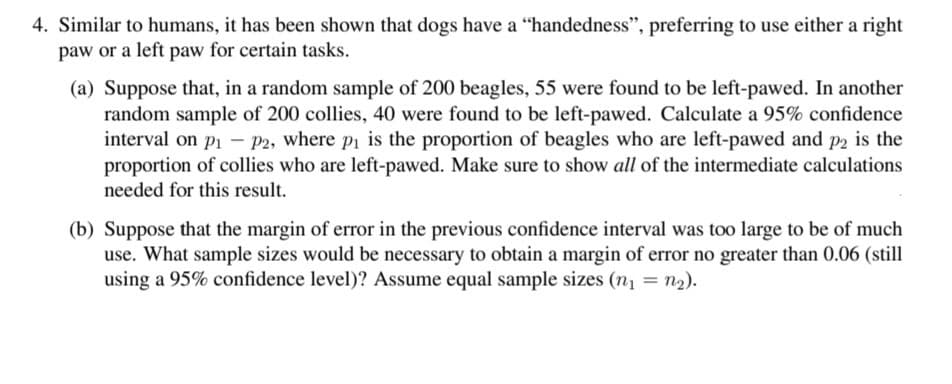Similar to humans, it has been shown that dogs have a “handedness", preferring to use either a right paw or a left paw for certain tasks. (a) Suppose that, in a random sample of 200 beagles, 55 were found to be left-pawed. In another random sample of 200 collies, 40 were found to be left-pawed. Calculate a 95% confidence interval on pi - P2, where pi is the proportion of beagles who are left-pawed and p2 is the proportion of collies who are left-pawed. Make sure to show all of the intermediate calculations needed for this result. (b) Suppose that the margin of error in the previous confidence interval was too large to be of much use. What sample sizes would be necessary to obtain a margin of error no greater than 0.06 (still using a 95% confidence level)? Assume equal sample sizes (n1 = n2).
Similar to humans, it has been shown that dogs have a “handedness", preferring to use either a right paw or a left paw for certain tasks. (a) Suppose that, in a random sample of 200 beagles, 55 were found to be left-pawed. In another random sample of 200 collies, 40 were found to be left-pawed. Calculate a 95% confidence interval on pi - P2, where pi is the proportion of beagles who are left-pawed and p2 is the proportion of collies who are left-pawed. Make sure to show all of the intermediate calculations needed for this result. (b) Suppose that the margin of error in the previous confidence interval was too large to be of much use. What sample sizes would be necessary to obtain a margin of error no greater than 0.06 (still using a 95% confidence level)? Assume equal sample sizes (n1 = n2).
MATLAB: An Introduction with Applications
6th Edition
ISBN:9781119256830
Author:Amos Gilat
Publisher:Amos Gilat
Chapter1: Starting With Matlab
Section: Chapter Questions
Problem 1P
Related questions
Question

Transcribed Image Text:4. Similar to humans, it has been shown that dogs have a "handedness", preferring to use either a right
paw or a left paw for certain tasks.
(a) Suppose that, in a random sample of 200 beagles, 55 were found to be left-pawed. In another
random sample of 200 collies, 40 were found to be left-pawed. Calculate a 95% confidence
interval on p1 - P2, where pi is the proportion of beagles who are left-pawed and p2 is the
proportion of collies who are left-pawed. Make sure to show all of the intermediate calculations
needed for this result.
(b) Suppose that the margin of error in the previous confidence interval was too large to be of much
use. What sample sizes would be necessary to obtain a margin of error no greater than 0.06 (still
using a 95% confidence level)? Assume equal sample sizes (n1 = n2).
Expert Solution
This question has been solved!
Explore an expertly crafted, step-by-step solution for a thorough understanding of key concepts.
Step by step
Solved in 4 steps with 5 images

Knowledge Booster
Learn more about
Need a deep-dive on the concept behind this application? Look no further. Learn more about this topic, statistics and related others by exploring similar questions and additional content below.Recommended textbooks for you

MATLAB: An Introduction with Applications
Statistics
ISBN:
9781119256830
Author:
Amos Gilat
Publisher:
John Wiley & Sons Inc

Probability and Statistics for Engineering and th…
Statistics
ISBN:
9781305251809
Author:
Jay L. Devore
Publisher:
Cengage Learning

Statistics for The Behavioral Sciences (MindTap C…
Statistics
ISBN:
9781305504912
Author:
Frederick J Gravetter, Larry B. Wallnau
Publisher:
Cengage Learning

MATLAB: An Introduction with Applications
Statistics
ISBN:
9781119256830
Author:
Amos Gilat
Publisher:
John Wiley & Sons Inc

Probability and Statistics for Engineering and th…
Statistics
ISBN:
9781305251809
Author:
Jay L. Devore
Publisher:
Cengage Learning

Statistics for The Behavioral Sciences (MindTap C…
Statistics
ISBN:
9781305504912
Author:
Frederick J Gravetter, Larry B. Wallnau
Publisher:
Cengage Learning

Elementary Statistics: Picturing the World (7th E…
Statistics
ISBN:
9780134683416
Author:
Ron Larson, Betsy Farber
Publisher:
PEARSON

The Basic Practice of Statistics
Statistics
ISBN:
9781319042578
Author:
David S. Moore, William I. Notz, Michael A. Fligner
Publisher:
W. H. Freeman

Introduction to the Practice of Statistics
Statistics
ISBN:
9781319013387
Author:
David S. Moore, George P. McCabe, Bruce A. Craig
Publisher:
W. H. Freeman